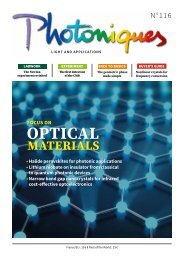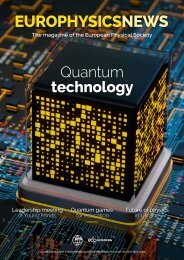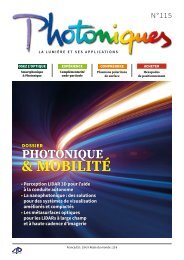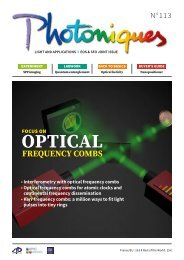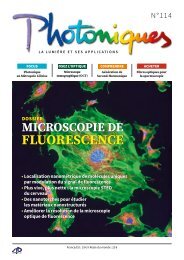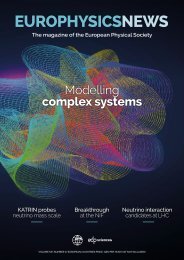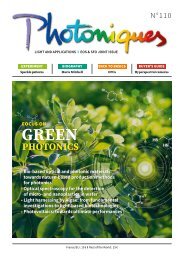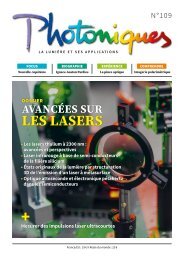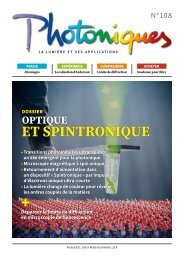EPN 53-3
Create successful ePaper yourself
Turn your PDF publications into a flip-book with our unique Google optimized e-Paper software.
FEATURES<br />
LASERS FOR HEALTH<br />
l Giulio Cerullo 1,2 and Renzo Vanna 2 – DOI: https://doi.org/10.1051/epn/2022305<br />
l 1 Dipartimento di Fisica, Politecnico di Milano, Piazza L. Da Vinci 32, 20133 Milano, Italy<br />
l 2 Istituto di Fotonica e Nanotecnologie-CNR, Piazza L. Da Vinci 32, 20133 Milano, Italy<br />
Thanks to its spatial and temporal coherence properties, laser light lends itself to a<br />
wealth of biomedical applications. We review the use of lasers in medical sciences, from<br />
microscopy for understanding the origin of diseases, to diagnostics for enhancing the<br />
accuracy of therapies to surgery of almost any organ of the human body.<br />
Light for life<br />
Light is intimately linked to life. Many bio-organisms<br />
have developed sophisticated molecular machineries to<br />
interact with light and exploit it for their functions. In<br />
photosynthesis, plants absorb solar energy in light-harvesting<br />
complexes and use it to drive charge separation<br />
and ultimately convert it into chemical energy [1]. The<br />
vision system of higher organisms is based on phototransduction<br />
triggered by the isomerization of the retinal<br />
chromophore within visual (opsin) proteins [2]. Some<br />
animals have learned to generate and manipulate light<br />
for improved survival and reproduction. Examples are<br />
fireflies and jellyfish which exploit chemical reactions in<br />
luciferin compounds to generate bioluminescence, which<br />
is used to attract preys, repel predators or to communicate.<br />
Other animals, such as peacocks and butterflies,<br />
use photonic crystal structures to generate bright color<br />
patterns [3].<br />
Light is also intimately linked to medicine, since almost<br />
every component of the electromagnetic spectrum<br />
can be used for diagnostic and therapeutic purposes [4].<br />
For example, radio waves are employed for magnetic resonance<br />
imaging (MRI), infrared and visible light finds<br />
application to microscopy and laser surgery, ultraviolet<br />
(UV) light is used for eye refractive surgery and for virus<br />
and bacteria disinfection, X-rays are employed for computed<br />
tomography (CT) and gamma rays for positron<br />
emission tomography (PET) and radiotherapy. We will<br />
here focus on the medical application of lasers, sources<br />
of coherent electromagnetic waves in the optical range<br />
of frequencies.<br />
Lasers and medicine<br />
The invention of the ruby laser by Theodor Maiman in<br />
1960 immediately triggered a variety of medical applications.<br />
Differently from natural light sources, lasers emit<br />
light at specific wavelengths, tunable from the infrared<br />
to the UV, and with a high degree of spatial coherence;<br />
in addition, mode-locked lasers generate ultrashort light<br />
pulses, with picosecond to femtosecond duration [5].<br />
These properties allow to concentrate large amounts of<br />
electromagnetic energy into small volumes, resulting in<br />
28 <strong>EPN</strong> <strong>53</strong>/3



